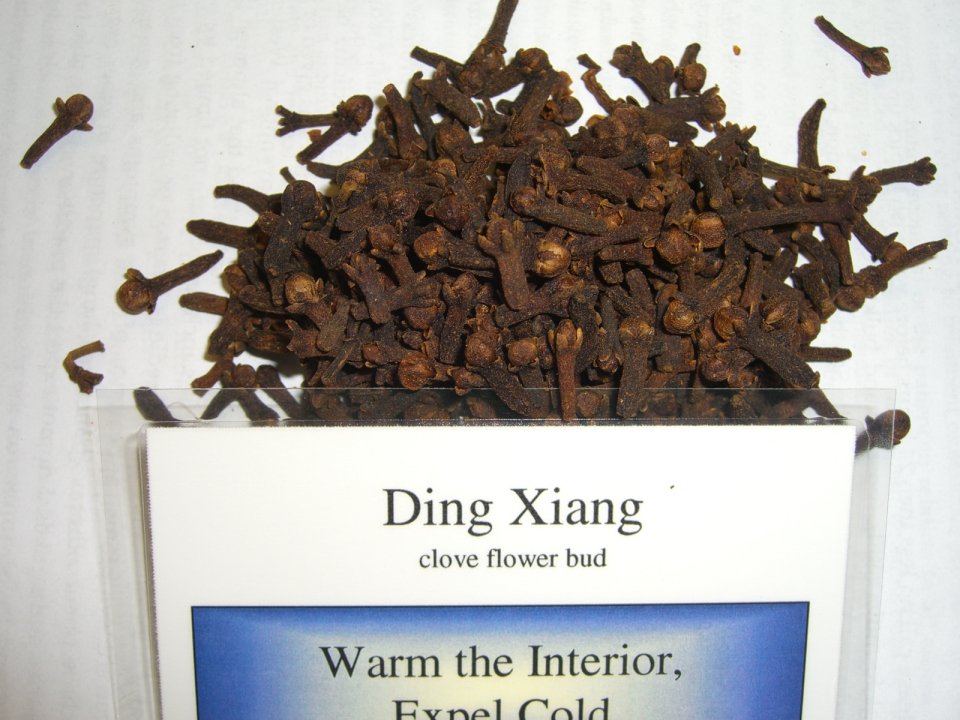Ding Xiang

  | Ding Xiang in TCM:Explore the properties of Ding Xiang according to Chinese
Nutrition and Traditional Chinese Medicine (TCM):
Factoids:
English Name: Clove
Pharmacuetical Name: Flos Caryophylli
Properties: acrid, warm
Temperature: warm
Channels: ST, SP, KD
Flavors: pungent
Tonifies: yang
Special Properties:
circulates qi, disperses cold
Alternate Forms:
- Ding Xiang Pi (Cortex Caryophylli) the bark from the same plant as Ding Xiang, it is used to dispel cold and relieve pain.
- Mu Ding Xiang (Fructus Caryophylli) is derived from the fruit of the same plant. It has the same functions as Ding Xiang but is longer lasting. It was first mentioned in the Ming Yi Za Zhu (Miscelleneous Records of Famous Physicians by Tao Hong-Jing in 500 A.D.)
Actions / Indications:
- Warms the middle jiao, reverses rising stomach qi; alleviates pain (hiccups, diarrhea, nausea, vomiting, SP and ST def. cold with lack of appetite, abdominal fullness and distension caused by cold, epigastric and abdominal pain caused by cold, promotes digestion by increasing bile and acid secretion).
- Warms the KD; assists yang (vaginal discharge due to cold in uterus, cold body and cold extremities, impotence, soreness of back and knees). To treat Kidney Yang deficiency combine Ding Xiang with Fu Zi, Rou Gui, and Ba Ji Tian.
Special Notes:
- For cold in epigastric and abdominal areas causing pain combine with Rou Gui and Gan Jiang [6]. For nausea and vomiting due to stomach cold combine it with Ban Xia and Sheng Jiang [6].
- For hiccups due to stomach cold add Shi Di (Calys Kaki)[6]. For hiccups due to cold and deficiency combine with Ren Shen or Dang Shen [6].
- For morning sickness in pregnant women combine it with Ren Shen and Huo Xiang[6]
- Fir diarrhea due to stomach cold and deficiency combine it with Ren Shen, Gan Jiang, Bai Zhu, and Rou Dou Kou [6].
- 31 patients had excellent results treating fungal infection with an herbal tincture applied to the affected area 3 times / day for 2-3 days. To make the tincture soak 15g of ding xiang in 100 mL of 70% alcohol for 48 hours [6].
- Antiobiotic: May inhibit Vibrio cholerae, Salmonella typhi, Cornebacterium diptheriae, Bacillus dysenteriae, E. coli, Bacillus subtilis, Staphylociccus aureus [6]
- Antitoxin: May help relieve toxicity of Potassium Cyanide and Sodium Nitrate [6]
- Essential Oil of Ding Xiang may relieve asthma for up to 6 hours [6].
Contraindications:
- (cc: antagonistic with yu jin)
- (cc: interior heat with yin deficiency)
- (cc: febrile disorders)
- (cc: potential side effects include dizziness, palpitations, chest oppression, perspiration, headache, skin rash, and decreased blood pressure) [6]
Disclaimer: In accordance with our terms of service, by using this web site you agree that none of the information found on this web site constitutes medical advice. You should always consult your doctor before trying any particular food or herbal remedy to treat disease.
Folk remedies presented on this site are designed to address specifc TCM diagnoses, and are not one-size-fits-all. If you would like to learn more about Traditional Chinese Medicine (TCM) and how it relates to Chinese Nutrition, you can book in a free call with a licensed professional. There is no obligation to purchase.
[CLICK HERE for your free INITIAL CONSULTATION] |

